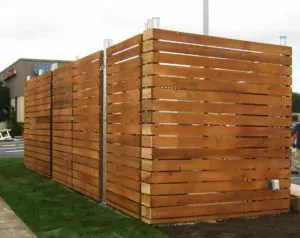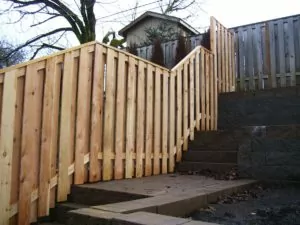Is your current fence one stiff wind away from being blown over or did you buy a new home and want to install a backyard fence? Before you start tearing out the old fence and digging post holes for the new fence, there are a few fence code requirements you need to be aware of. Here’s what to do before building a fence in Oregon.
In most cases, fence building codes are pretty uniform when it comes to height, setback requirements, and so forth. But in addition to any codes or requirements, you should think about what kind of fence you want, its uses, and its materials. There are also ways of building a fence to get the best results.
What to do Before Building a Fence in Oregon
When it comes time to build a fence, it’s really a three-part process. Here are a few guidelines to follow before you begin:
- Research Fence Building Codes
- Choose Where The Fence Will Go
- Choose Your Fencing Materials
- Plan Your Fence
- Building Your Fence
Research Fence Building Codes
Depending on the size of your fence, it may not require a building permit at all. In Portland, your fence project doesn’t need a permit if it’s a wood fence (or similar material) less than seven feet tall or a stone/masonry fence less than four feet tall. Chain link fencing can go even higher without a permit: they can be up to eight feet tall without the paperwork.
If you’re building a fence higher than the maximum heights listed above, you’ll need a permit. Depending on the height of your fence and how long the fence line is, extra engineering may be required. A ten-foot fence that has posts buried just 18 inches in the ground won’t stand for very long.
Keep in mind, these heights are for fences constructed in areas of residential zoning. Commercial fencing permits in the city of Portland include a lot more variables. Visit the Portland commercial building permit site for more information. On a final note: permits are required for fences that go around a swimming pool as well as retaining walls of a certain height.
Choose Where the Fence Will Go
This is also part of the permitting process because you’ll have to take into account property lines, setbacks, and more. There are differences between if you’re building a small fence in the front of the house or a larger fence in the backyard along the property line.
It also makes sense to talk with any neighbors about fencing plans just as a common courtesy. You’ll also want to make sure you don’t accidentally cut into any power lines or other buried infrastructure while digging holes for fence posts. Visit callbeforeyoudig.org and they will let you know where any electrical lines, plumbing, telecommunications, and other lines may be buried.
After you’ve decided on a fence height, the materials, and where the fence will go and you need a permit, complete a building permit application here in the city of Portland. Other cities will have their permit process, too, so if you’re in Lake Oswego, West Linn, Beaverton, or elsewhere, make sure you check their fence installation codes.
What to do Before Building a Fence: Choose Your Fencing Materials
As a property owner, there are many different uses for a fence: security, privacy, appearance, and so forth. With a wide variety of materials to choose from–chain link, wood, vinyl–there will be differences in cost, tools needed, and installation time. Cedar fencing will also look great, but needs more maintenance than vinyl or chain link.
There are a lot of variables to take into account, including the ease of installation if you’re doing it yourself. Once settling on the materials of choice, you’ll have a better idea of what the cost will be once you’ve planned out exactly where the fence will go, including any opening or gates.
Plan Your Fence
In addition to checking with the city, your HOA, any CCRs you need to follow, and even your neighbors (as a courtesy remember), it’s now time to plan your fencing installation. If you are replacing an existing fence, figure out how to take the fence apart and where the debris will go.
Make note of the fence posts to see if you can reuse the hole left behind. If not, mark where the new post holes will go (stakes, flags, spray paint), although you should always measure from post hole to post hole. Once post holes are marked, and you’ve gathered your materials, you’re ready to build!
Building Your Fence
You can gain a lot of satisfaction from building your own fence. From setting the post holes to attaching the rails to adding the fence slats or panels. But it can also be a lot of work and if the fence is time-sensitive (keeping pets secure in the back yard for example), you should plan on a long weekend to get it done.
If you’ve decided on having a professional fencing contractor install your fence, look no further than Pacific Fence & Wire. We have more than 100 years of building experience in Portland and surrounding areas. Whether it’s wood, vinyl, chain link, or even wire, we understand the codes, requirements, and regulations to build your fence to the exact specifications.





